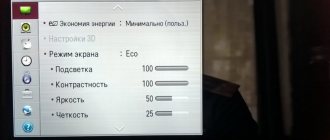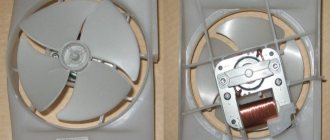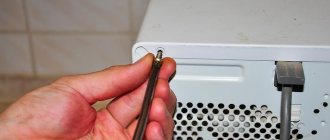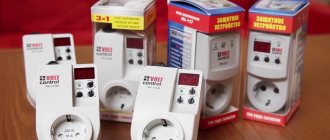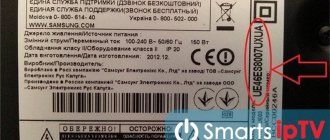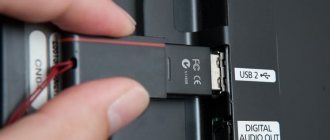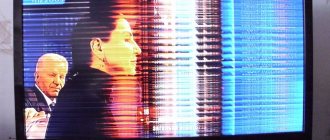Modern TV receivers are sophisticated, technically advanced products. They are designed for supply voltages that vary widely, as well as other parameters. There are practically no defects in TVs out of the box. The user is not required to troubleshoot any abnormal operation of the device. However, this does not mean that a TV malfunction cannot occur in principle. It is not recommended to try to fix serious problems yourself. It is better to immediately take the TV to a service center or call a specialist for professional diagnostics at home.
How LCD TVs work
The average user is sure that the main part of LCD TVs is the screen. Yes, this functional unit is indeed complex. But the image on it is formed thanks to signals supplied by the central processing platform, roughly speaking, the device’s motherboard.
The main role in the design of LED TVs, despite its relative simplicity, is played by the power supply . It is this that allows a particular model to work with a wide range of voltages, while simultaneously supplying all functional units with a controlled level of energy supply necessary for their stable and correct operation.
If any structural unit fails, the TV stops showing. In particular, it is impossible to understand from the image on the screen how its backlight works. But when it fails, you can see the picture only by shining a flashlight on the matrix. So, the main failures of LCD TVs can occur:
- in the matrix, the area where controlled translucent cells are located;
- in the power supply;
- in the backlight inverter assembly;
- due to failure of electronic components of the motherboard and timing control unit.
DIY LCD TV repair
You can repair an LCD TV yourself, but for this you will need a minimum set of tools.
- Multimeter – determines voltage at test points;
- Oscilloscope – compares signals at individual points with the circuitry of the TV itself;
- Amplifier – determines where the sound signal disappears.
You will also need a set of screwdrivers (including hexagons), a blowtorch with a hair dryer, pliers and appropriate tools. It is best to take a specialized kit specifically for repairing modern LCD TVs.
In addition, you need to accurately understand all your actions and at least understand the structure of modern televisions and be able to read diagrams. Today, more sophisticated electronics are used, which require slightly different knowledge.
If you are not confident in your abilities, it is better to use the services of TV repair specialists who have all the necessary tools, relevant skills and experience in troubleshooting.
Main causes of breakdowns
The reasons for a TV breakdown can be different. In a large number of cases, these are power surges, static breakdowns along the antenna cable (or due to lightning strikes), and emergency situations on connected equipment. There are also purely technological failures of hardware components due to their manufacturing defects.
Important! A huge number of cases of contacting service centers are TV malfunctions caused by its improper operation.
Trying to fix TV problems yourself can be dangerous. In most cases, inexperienced actions can cause additional troubles. Among other things, such user operation voids the manufacturer's warranty. However, the causes of a TV breakdown, correctly diagnosed by visible failures and cases of abnormal behavior of the device, will allow you to quickly call a technician or deliver the product to a service center.
The TV does not turn on or turns off spontaneously
Problems with turning on the TV are also very common. The following reasons usually lead to them:
- power supply failure. This device, which powers the television receiver, is too susceptible to sudden changes in network voltage. To prevent its malfunction, it is recommended to connect a stabilizer. It will equalize the voltage at times of increased load and protect the power supply from damage;
- the appearance of microcracks on the TV system board. In this case, the part will need to be replaced, since it will be quite difficult to restore it after such defects occur;
- contact closure or electrical circuit breakage. Ringing the device using special equipment will help you quickly find the damaged area and restore normal contact between the modules.
Another problem that owners of modern TVs often encounter is the device turning off spontaneously. It arises for almost the same reasons as difficulties with inclusion. Testing the power supply and diagnosing the system board will help you find the problem.
If you could repair old tube TVs yourself even with minimal knowledge and skills, then it’s unlikely to be possible to understand the design of modern devices without an experienced technician. Therefore, contacting a specialized service is the most reasonable solution when identifying any symptoms of a breakdown described above.
Rating 1.0 out of 5. Votes: 1
| RSS |
Matrix faults
Malfunctions of LCD TVs associated with incorrect operation or damage to the light-transmitting display matrix can be easily identified by the user by visible signs. There are two groups of breakdown options. One includes malfunctions of the signal transmission system. Secondly, physical damage to the matrix itself.
- Factory dead pixels. It is recommended to find them while purchasing a TV in the store. According to the standards, there should not be more than 5 dots on the entire screen plane that do not change color when the image is reproduced. If there are more of them, the device is not worth buying. Dead pixels cannot be repaired.
- Damaged pixels. The LCD display matrix is quite fragile, and in most TVs it is covered with a thin plastic plate. As a result of an impact, pixels (cells of liquid crystals with controlled light transmission) can be damaged over a large area. As a result, a spot is formed, most often black (on some matrices it is white).
- Results of exposure to vibration, moisture, hypothermia. In all these emergency situations, a wide variety of spots and stains form on the TV display. These may be areas with irreparably damaged pixels. Or they stop handling normally, distort colors, and cannot reproduce the correct range of shades.
The group of options for abnormal behavior of a TV screen is more diverse. If the cable tracks on the matrix are damaged, the picture may malfunction, from stripes and interference to breaking into squares and incorrect colors .
It is simply impossible to describe all the cases; they are chaotic and largely unique.
Power supply failure
TV malfunctions associated with a breakdown or incorrect operation of the power supply occur only as a result of network voltage surges.
Advice! It is recommended to connect all TVs without exception via stabilizers. Or, at a minimum, surge protectors that eliminate interference and voltage surges.
Typical signs that the TV power supply has stopped performing its functions include:
- the device does not turn on;
- the TV starts to work, but after a while it turns off on its own;
- the device turns off when trying to program or call up the on-screen menu, when switching channels;
- When you try to turn on, the readiness indicator lights up and goes out, blinking.
If there is insufficient output power on individual circuits, the TV screen may not light up. At the same time, the device regularly reproduces sound, switches channels, and responds to other commands from the remote control and body buttons. What exactly to repair in the power supply should only be decided by a qualified technician after thorough testing. Including reading data from internal service statistics of the TV’s self-diagnosis.
Common malfunctions of popular brands of TVs
Samsung
Service center specialists point out that a common malfunction of Samsung TVs is most often the firmware. Because of this, spontaneous shutdowns, freezing and image stuttering may occur. Often, unstable firmware puts the TV into constant overload mode, which leads to a variety of problems.
LG
The most common problems with LG TVs are switching to automatic mode (processor problem), narrow bars on the screen (capacitor problem) and not saving settings (solved by updating the firmware).
Philips
Sometimes on Philips TVs the image is displayed in a distorted form, which indicates a problem in the microcircuits. Or the device does not respond to button presses, which indicates memory problems or a malfunction of the control panel. There is also a weak picture brightness, which may be caused by problems with the screen backlight.
Failure of the backlight inverter
If the TV screen does not start up during normal sound playback, it is recommended to pick up a flashlight and shine it on the matrix . In the event that the inverter board is broken or malfunctions, the user will see a completely normal image on it at the place where the light falls.
The backlighting system of a modern TV is relatively simple. It is linear in inexpensive models; LEDs operate in the same color spectrum. In advanced products, a more complex system of light cells is installed. But in any case, this set of light emitters requires a precisely controlled, stabilized power supply.
The inverter board performs two tasks. On the one hand, it increases the motherboard signal voltage to the level necessary to trigger the backlight. On the other hand, it stabilizes the output current. The following may indicate board failure:
- completely dark screen;
- uneven illumination, from zonal (different at the bottom and at the top) for inexpensive Edge LED systems, to spotty for Direct LED;
- Instability of LED start-up, individual areas of the screen flash, flicker, light up and go out.
Important! Most TVs have the inverter board located at the bottom of the display. The user's hand will feel warm in this area if the node fails and makes multiple attempts to start.
If this situation occurs even during normal TV operation, it is recommended that the device be thoroughly tested. Perhaps the inverter is holding on, as they say, with all its strength, and its breakdown is very close.
The motherboard is faulty
On the motherboards of modern TVs there are many linear electrical components (resistors, capacitors, diodes, etc.) and complex microelectronic chips installed. This block is responsible for most functions. Including the interface for communicating with the user, the programming system and monitoring the operating parameters of other system modules.
If the motherboard is seriously damaged, the TV will not even turn on. However, if no problems were detected during self-diagnosis, but the module is malfunctioning, they may appear when watching TV.
Important! It is worth understanding that a separate motherboard chip is occupied with servicing the peripherals (input and output ports). If it breaks, everything works except the inputs and outputs of the TV.
Problems with the motherboard can be identified by the following signs:
- the TV does not respond to commands every time, it does it slowly, for example, it switches channels;
- There is noise on the display;
- the TV suddenly turns off or goes to the on-screen menu;
- settings fail;
- When attempting to access the OSD menu or programming, the TV turns off or goes to the GUI home page.
The motherboard must be repaired if any signs of malfunction appear. If this is not done, even a minor breakdown can cause a cascade of failures, leading to complete failure of the module.
What can you repair yourself?
It is better not to touch the hardware of LCD TVs without having a basic understanding of its structure.
However, with preparation, you can do the following:
- Repair the power supply unit;
- Repair the remote control;
- Replace faulty lamps in the backlight unit;
- Deal with the lack of a television signal.
IMPORTANT! Think ten times before changing the matrix on your device. Compare the price of the finished device with the cost of the matrix for it. Repair work will also need to be paid for; otherwise, there is a high probability of accidentally damaging both the new matrix and other entire elements of your TV. If you order repair work, you will at least be able to receive compensation for unfair repairs.
Is it possible to repair the matrix yourself? In most cases, repairing the LCD matrix is impossible.
Problems with the remote control
Possible malfunctions of the remote control and methods for correcting them:
- The batteries are dead. Replace them with new ones.
- The inside of the device is overgrown with dust and dirt. Disassemble it and thoroughly clean the stuck together insides, paying special attention to the contacts.
- The remote control was filled with liquid. Dry it. To improve the efficiency of the process, dry the remote control after it has been disassembled and cleaned.
If these simple operations do not help rehabilitate the remote control, just buy another one. Getting rid of the old device and replacing it with a new one is easier and faster than diagnosing the problem for a long time and then spending a lot of time on repairs. Remote controls usually cost less than your time.
No signal
Today, TVs are equipped with noise reduction technology. This leads to the fact that the TV simply refuses to turn on if it does not receive a TV broadcast signal. When there is no TV signal, the TV simply goes into standby mode. Therefore, before you panic and look for problems in the device itself, start with a simple check for the presence of a television broadcast signal.
Power supply repair
It is better to entrust repairs to the power board of an LCD TV to specialists. Don't neglect your safety. A poorly done LCD TV repair can cost more than qualified assistance from specialists. Do not start repairing the power supply yourself if you do not have the tools and knowledge of radio electronics.
The easiest way is to replace the capacitors on the power board. Even a person without special training can cope with this task. However, it is also important to make sure that you have correctly diagnosed the device problem. Take special tools or call a specialist right away.
How to replace swollen capacitors on a power supply:
- Disconnect the device from the network;
- Discharge the high-voltage capacitor using an external device. An ordinary light bulb is suitable for discharging. Place the lamp connector against the capacitor for a few seconds.
- Remove the screws from the back of the TV and remove the cover. Handle the latches located on the inside carefully, otherwise you will not be able to put the cover back in place smoothly and beautifully.
- The power supply is located away from the motherboard. Visually locate 3 transformer modules on the power supply. These include: device standby transformer, inverter power supply, voltage stabilizer choke. A choke is an inductance coil, a kind of limiter that smoothes out the operation of the electric current passing through it. The standby mode of the TV is when the TV is “turned off”, while connected to the electrical network.
- The voltage on the standby transformer of the device connected to the network must correspond to the value of 5V. On the device diagram or by studying the information printed on top of the housing, find a contact labeled with this value.
- If you have a tester, inspect the circuit for an open. Place 1 probe to the 5-volt contact, the other to the cathode of the diode located on the radiator.
- Connect the TV to the network and move 1 probe to the device body.
- Measure the voltage. If the voltage is less than 5V, this may indicate that the capacitors have failed to cope with the load and need to be replaced.
- Inspect the capacitors above the transformer for swelling. Swollen capacitors are destined for disposal.
- Inspect the capacitors below for dryness.
- First disconnect the matrix cable and all wires from the power board.
- Remove the 4 screws from the board.
- Discharge all capacitors using a voltmeter, light bulb or 5-10 watt resistor.
- Use a soldering iron to remove the damaged capacitors.
- Then solder the new parts. Don't get confused with polarity.
- Return the board to its place by tightening the screws, connecting the cable and wires. Replace the cover.
- Measure the voltage at the transformer. If the voltage is 5V, the job is successful.
IMPORTANT! If you don't discharge the capacitors, you risk getting electrocuted! To repair your TV safely, first remove the charge from the capacitors.
Replacing backlight bulbs
You don't need any special skills to replace lamps. For this, elementary caution and a good memory are enough. Repairing a tube TV involves preliminary disassembling the device into its component parts. To avoid getting confused later in the assembly process, you can take photos of the stages of the process with your phone or camera.
Step-by-step instruction:
- Disconnect the device from the network;
- Carefully remove the back cover from the device;
- Carefully remove all cables leading to the matrix from their sockets;
- Disconnect the control panel;
- Remove the housing with the circuit boards;
- Before removing the matrix, unscrew the frame;
- Using gentle pressure, remove the snap fastening to release the matrix and filters;
- Connect the TV to the network;
- Press the buttons on the control module, call the service menu;
- When the lamps light up, identify the damaged backlight elements;
- Replace broken lamps;
- Assemble the apparatus;
- Reset lamp errors: find the corresponding line in the service menu and reset the indicator.
Damage to the timing control board (T-con)
The timing controller board is one of the most reliable components of the TV. It works in completely safe modes. On the one hand, it receives commands from the motherboard. At the output, it transmits a signal to the display matrix control system. However, you should not think that this module will not break. The board may overheat, dust and cockroach droppings accumulate on it. Don’t forget about humidity fluctuations and banal factory defects.
Signs of a T-con board failure can be determined by the image on the screen . It may become uniformly colored, gray or white. Typical symptoms include various image artifacts, blocks of image construction failure, stripes and temporary snow, and interference. Often there is a violation of the color scheme or the transition of the picture to black and white format.
Many manufacturers offer standardized timing control boards in their device series. As a result, the user has no problems with either the availability or the excessively high cost of these modules. Therefore, at the first signs of problems detected, you should definitely contact a service to repair your TV.
